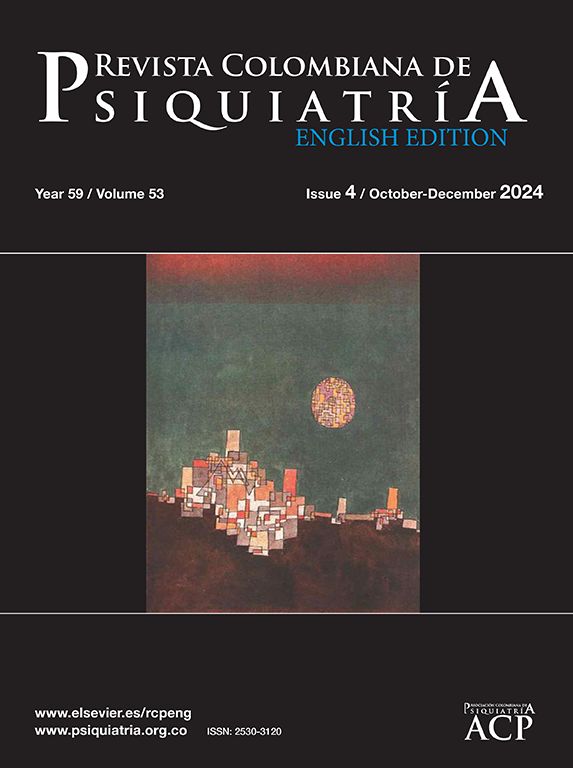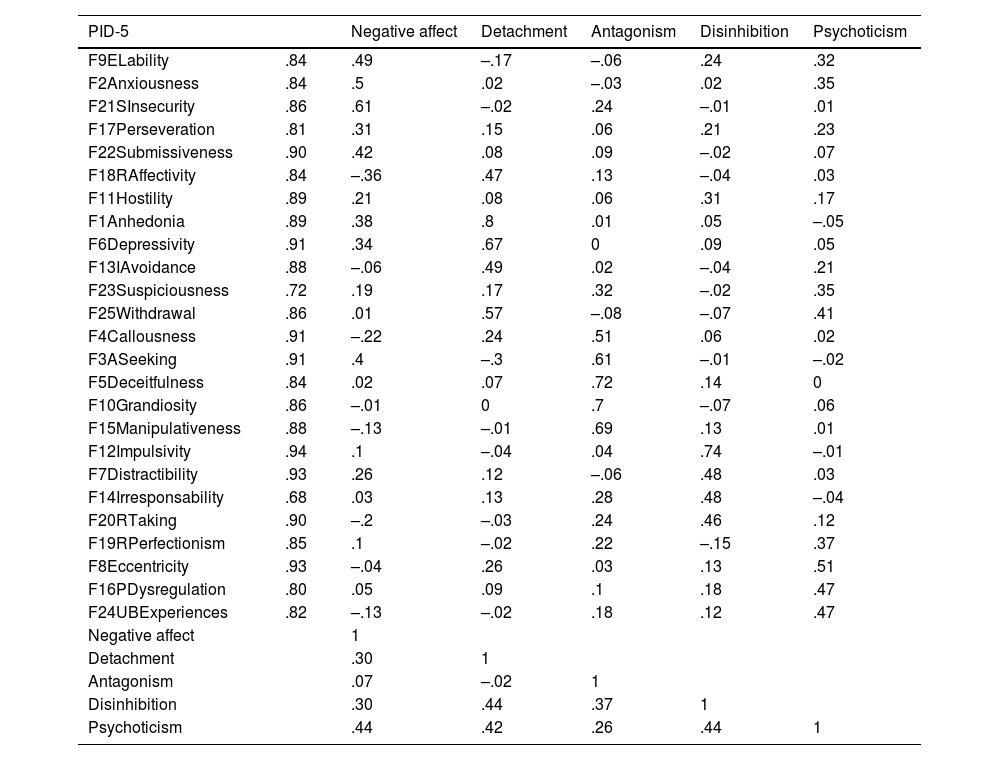The aim of the present study was to verify the psychometric qualities of the PID-5-FBF in a community sample of Brazilian adults. The internal consistency of the facets and the internal structure of the dimensions were checked. In addition, we verified the correlations between the PID-5-FBF facets and domains with a five-factor model measure.
MethodsThe sample of this study consists of the 774 Brazilian adults aged 18 to 73 years (mean 28.9±11.58) who answered the PID-5-FBF and BFI-2S.
ResultsThe alpha values were adequate. The internal structure was similar to the PID-5 original form. All the factors and dimensions of the PID-5-FBF have a negative association with agreeableness, while, on the other hand, all correlations with neuroticism were positive. Neuroticism was the factor with the highest correlation with the PID-5-FBF, and openness was the one with the lowest number of correlations.
ConclusionsThis research contributes to adding evidence of validity to the PID-5-FBF in the Brazilian community sample. Our results are important because it is the first study with the PID-FBF in a Brazilian sample.
El objetivo del presente estudio es verificar las cualidades psicométricas del PID-5-FBF en una muestra comunitaria de adultos brasileños. Se comprobó la consistencia interna de las facetas y la estructura interna de las dimensiones. Además, se verificaron las correlaciones entre las facetas y los dominios de PID-5-FBF con una medida del modelo de 5 factores.
MétodosFormaron la muestra de este estudio los 774 adultos brasileños de 18 a 73 (media, 28,9±11,58) años que respondieron al PID-5-FBF y BFI-2S.
ResultadosLos valores alfa fueron adecuados. La estructura interna era similar a la forma original del PID-5. Todos los factores y dimensiones del PID-5-FBF tienen una asociación negativa con la agradabilidad y, por otro lado, todas las correlaciones con el neuroticismo fueron positivas. El neuroticismo fue el factor con mayor correlación con el PID-5-FBF y la apertura, el de menor número de correlaciones.
ConclusionesLa presente investigación contribuye a agregar evidencia de validez al PID-5-FBF en la muestra de la comunidad brasileña. Nuestros resultados son importantes porque es el primer estudio con PID-FBF en una muestra brasileña.
Personality disorders have about 10% prevalence in the community sample and can be about 20% clinical group.1 In Colombia,2 a research showed a high prevalence of pathological traits. These traits were mainly related to borderline personality disorder, present in about 4.6% of the population. Personality disorder causes impairment and suffering. and that are why it needs to be identified and treated.
The official model for diagnosing personality disorder is reported in section II of the Diagnostic and Statistical Manual of Mental Disorders (DSM-5), and adheres to a categorical approach. The person needs to have a specific number of criteria to be considered positive for personality disorder in the categorical model.3 For example, the person needs to have five out of nine criteria to be considered positive to borderline personality disorder. Several criticisms of the categorical approach have been reported in the literature such as heterogeneity, high comorbidities between PD's, lack of empirical evidence for the number of criteria used for diagnosis, and temporal instability.
Due to problems in the categorical model and wide acceptance of the five-factor model (dimensional perspective) in the world, the authors of DSM-5 created an alternative model for diagnosis of personality disorders reported in the emerging model's session and a hybrid model with a categorical approach with A criteria and B criteria with the dimensional approach. Criterion A assesses overall personality impairment based on impairments of the self and interpersonal relationships, and criterion B assesses 25 pathological personality traits that make up pathological personality profiles.3–7
Kruger et al.,8 developed a test based on the alternative model of personality disorders. The Personality Inventory for DSM-5 (PID-5) is a self-report scale composed of 220 items answered on a 4-point Likert scale. The PID-5 items are distributed in 25 facets that assess 25 traits reported in DSM-5 section III criterion B and facets cluster in five domains (negative affect, detachment, antagonism, disinhibition, psychoticism). The PID-5 shown validity evidence in different studies and countries.9–15Despite the relevance and contribution of the PID-5 in the clinical setting, the number of items limits the use of this test in other contexts that needs quick assessments (e.g., selection of employees, public health service, forensic). A PID-5 version with only 25 items was developed by Kruger et al.16 serving as a screening; however, it does not have the facets observed in the original version, only dimensions, which limits inferences with the test results. Maples et al.,17 by investigating item response theory with PID-5 items, selected the top 100 items and proposed a new version of the PID-5 Faceted Brief Form (PID-5-FBF). The PID-5-FBF maintains the original structure of the original version with 25 facets and five domains, but different from the original version — each facet is composed of only four items. The PID-5-FBF demonstrated strong reliability and a nearly identical correlational profile with the original PID-5 across a wide range of external criteria, including Five Factor Model domains and facets.
Besides Maples et al.,17 other studies have indicated adequate validity evidence and reliability to PID-5-FBF.7,15 Bach et al.,9 found congruence between the PID-5 original internal structure and PID-5-FBF internal structure and shown a good discriminatory capacity, similar results with original form. Pires et al.18 found good internal consistence and good correlation between PID-5-FBF dimensions and NEO-FFI facets positive with neuroticism and negative with agreeableness. The authors concluded adequate properties psychometrics to PID-5-FBF.
The current studyThe aim of the present study was to verify the psychometric qualities of the PID-5-FBF in a community sample of the Brazilian adults. It was checked the internal consistency of the facets and the internal structure of the dimensions. Besides, we verified the correlations between PID-5-FBF facets and domains with a five-factor model measure. Were created hypotheses based in previous study: h1) most internal consistency values would be >.70;8,10,18h2) internal structure would be similar to the original form,19 and h3) PID-5-FBF factors and dimensions would be correlated with five factors model, more specifically, positive with neuroticism and negative with agreeableness.18,20,21
MethodParticipantsThe sample of this study consists of the 774 Brazilian adults aged 18 to 73 (mean, 28.9±11.58) years, mostly female (80.7%), white (64.7%), and single (65%). 41.5% had completed high school, and 20.7% had completed higher education. Regarding psychiatric history, 28.3% reported some psychiatry diagnose. Details on the sample demographics are presented in table 1.
Sociodemographic data.
| Age (years) | Mean±SD | 28.9±11.58 | ||||
|---|---|---|---|---|---|---|
| Min-Max | 18-73 | |||||
| Sex | Female | Male | ||||
| Raw | 625 | 149 | ||||
| % | 80.7 | 19.3 | ||||
| Scholar degree | Basic | High School | Graduate | Postgraduate | ||
| Raw | 14 | 321 | 160 | 133 | ||
| % | 1.8 | 41.5 | 20.7 | 17.2 | ||
| Brazil's region | South | Southwest | North | Northeast | Middle-west | |
| Raw | 163 | 504 | 34 | 37 | 36 | |
| % | 21.1 | 65.1 | 4.4 | 4.8 | 4.7 | |
| Ethnicity | Caucasian | Brown | Black | Asian | Other | |
| Raw | 501 | 194 | 54 | 12 | 13 | |
| % | 64.7 | 25.1 | 7.0 | 1.6 | 1.7 | |
| Marital status | Single | Married | Divorced | Widowed | Other | |
| Raw | 503 | 211 | 32 | 6 | 22 | |
| % | 65.0 | 27.3 | 4.1 | .8 | 2.8 | |
| Psychiatry diagnoses | Yes | No | ||||
| Raw | 219 | 774 | ||||
| % | 28.3 | 71.7 | ||||
| Suicide attempt | Yes | No | ||||
| Raw | 170 | 604 | ||||
| % | 22.0 | 78.0 |
The PID-5-FBF is a short version of the Personality Inventory for DSM-5. The PID-5-FBF is composed of 100 items distributed in 25 facets and 5 factors, and this test is a self-report scale that measures maladaptive personality traits described in section III of the DSM-5. The items should be responded on a 4-point Likert scale, where 1 means “nothing” and 4 means “a lot”. Previous studies showed adequate evidence validity to PID-5-FBF.18
Big Five Inventory-2 ShortThe BFI-2-S is a self-report measure of personality traits based on the Five-Factors Model (FFM), evaluating extroversion, agreeableness, conscientiousness, neuroticism, and openness. This measure is composed of 30 items and must be answered on a 5-points Likert scale. Previous study showed adequate validity evidence to BFI-2-S.22,23 The internal consistency reliability in this study was extroversion (α=.80), agreeableness (α=.79), conscientiousness (α=.78), neuroticism (α=.89), and openness (α=.75).
ProcedureThis study's procedures complied with the Declaration of Helsinki provisions regarding research on human participants, and was approved by the Ethics Committee of the São Francisco University. All participants signed an informed consent form before participating. Data collection was performed on-line via Google Forms. We shared the research link on the social media website (Facebook) and via WhatsApp, inviting individuals to participate and engaging on the snowball strategy to reach a more substantial number of participants.
Data analysisA descriptive analysis was performed to characterize the sample of this study. We verified the facets internal consistency using Cronbach alfa's. A parallel analysis was performed and an exploratory factor analysis (EFA) forcing five factors with base in literature about PID-5. It was used the ML estimator and oblique rotation. The χ2 and degrees of freedom ratio, confirmatory fit index (CFI>.90), Tucker-Lewis Index (TLI>.90), and Root Mean Square Error of Approximation (RMSEA<0.08) indicators were used to verify which model best adjusted the data.24 The reliability was verified through Cronbach alpha's. Pearson's correlation test, with significance if P<.05, was used to identify the associations between the PID-5-FBF factors and BFI-2-S factors, based on Cohen25 interpretation of magnitudes, being weak (<.10), moderate (around .30) or strong (around .50). The software packages for the data analysis were SPSS 20.1 and Mplus 7.11.
ResultsThe first analysis carried out was the internal consistency of the 25 facets. Later on, we did a parallel analysis and EFA. The parallel analysis indicated the maximum of the 5 dimensions in the data matrix. The Model Fit Indicators were χ2 and degrees of freedom ratio=4.2 (RMSEA=.06; TLI=.89; CFI=.92). The factor loading and dimensions correlation are shown in Table 2.
Exploratory factor analysis of the PID-5-FBF.
| PID-5 | Negative affect | Detachment | Antagonism | Disinhibition | Psychoticism | |
|---|---|---|---|---|---|---|
| F9ELability | .84 | .49 | –.17 | –.06 | .24 | .32 |
| F2Anxiousness | .84 | .5 | .02 | –.03 | .02 | .35 |
| F21SInsecurity | .86 | .61 | –.02 | .24 | –.01 | .01 |
| F17Perseveration | .81 | .31 | .15 | .06 | .21 | .23 |
| F22Submissiveness | .90 | .42 | .08 | .09 | –.02 | .07 |
| F18RAffectivity | .84 | –.36 | .47 | .13 | –.04 | .03 |
| F11Hostility | .89 | .21 | .08 | .06 | .31 | .17 |
| F1Anhedonia | .89 | .38 | .8 | .01 | .05 | –.05 |
| F6Depressivity | .91 | .34 | .67 | 0 | .09 | .05 |
| F13IAvoidance | .88 | –.06 | .49 | .02 | –.04 | .21 |
| F23Suspiciousness | .72 | .19 | .17 | .32 | –.02 | .35 |
| F25Withdrawal | .86 | .01 | .57 | –.08 | –.07 | .41 |
| F4Callousness | .91 | –.22 | .24 | .51 | .06 | .02 |
| F3ASeeking | .91 | .4 | –.3 | .61 | –.01 | –.02 |
| F5Deceitfulness | .84 | .02 | .07 | .72 | .14 | 0 |
| F10Grandiosity | .86 | –.01 | 0 | .7 | –.07 | .06 |
| F15Manipulativeness | .88 | –.13 | –.01 | .69 | .13 | .01 |
| F12Impulsivity | .94 | .1 | –.04 | .04 | .74 | –.01 |
| F7Distractibility | .93 | .26 | .12 | –.06 | .48 | .03 |
| F14Irresponsability | .68 | .03 | .13 | .28 | .48 | –.04 |
| F20RTaking | .90 | –.2 | –.03 | .24 | .46 | .12 |
| F19RPerfectionism | .85 | .1 | –.02 | .22 | –.15 | .37 |
| F8Eccentricity | .93 | –.04 | .26 | .03 | .13 | .51 |
| F16PDysregulation | .80 | .05 | .09 | .1 | .18 | .47 |
| F24UBExperiences | .82 | –.13 | –.02 | .18 | .12 | .47 |
| Negative affect | 1 | |||||
| Detachment | .30 | 1 | ||||
| Antagonism | .07 | –.02 | 1 | |||
| Disinhibition | .30 | .44 | .37 | 1 | ||
| Psychoticism | .44 | .42 | .26 | .44 | 1 |
The factors showed good consistency internal, mostly values>.80, except suspiciousness and irresponsibility, with .72 and .68, respectively. The EFA results indicate that almost all loads were in the expected dimensions, with loading>.30. Only hostility, suspiciousness, and rigid perfectionism did not load in the expected dimension. Hostility load in disinhibition dimension, suspiciousness and rigid, besides perfectionism load in psychoticism dimension. Nevertheless, we can observe many of cross loadings. There were significant correlations between all dimensions, except antagonism with negative affect and detachment. The correlations between PID-5-FBF dimensions and the big five factors are shown in Table 3.
Correlations between PID-5-FBF dimensions and the big five factors.
| Extraversion | Agreeableness | Conscientiousness | Neuroticism | Openness | |
|---|---|---|---|---|---|
| Emotional lability | –.175a | –.047 | –.202a | .494a | –.116a |
| Anxiousness | –.240a | –.114a | –.163a | .597a | –.072 |
| Hostility | –.070 | –.422a | –.217a | .686a | –.168a |
| Perseveration | –.270a | –.265a | –.329a | .429a | –.105b |
| Separation insecurity | –.151a | –.015 | –.186a | .333a | –.130a |
| Submissiveness | –.288a | .015 | –.201a | .256a | –.144a |
| Restricted affectivity | –.192a | –.381a | –.070 | .007 | –.081 |
| Anhedonia | –.484a | –.338a | –.360a | .549a | –.231a |
| Depressivity | –.429a | –.275a | –.296a | .560a | –.183a |
| Intimacy avoidance | –.274a | –.291a | –.101b | .240a | –.029 |
| Suspiciousness | –.128a | –.398a | –.248a | .395a | –.043 |
| Withdrawal | –.477a | –.422a | –.222a | .409a | –.128a |
| Callousness | –.050 | –.492a | –.182a | .140a | –.137a |
| Attention seeking | .239a | –.120a | –.154a | .191a | .061 |
| Deceitfulness | –.099b | –.438a | –.319a | .313a | –.048 |
| Grandiosity | .061 | –.399a | –.159a | .133a | .022 |
| Manipulativeness | .097b | –.383a | –.186a | .149a | .036 |
| Impulsivity | –.064 | –.244a | –.318a | .444a | –.159a |
| Distractibility | –.287a | –.141a | –.527a | .413a | –.133a |
| Irresponsibility | –.192a | –.354a | –.544a | .376a | –.102b |
| Risk taking | .128a | –.281a | –.179a | .220a | .041 |
| Rigid perfectionism | .010 | –.141a | .164a | .203a | .106b |
| Eccentricity | –.290a | –.417a | –.274a | .382a | .032 |
| Perceptual Dysregulation | –.218a | –.244a | –.203a | .364a | –.047 |
| Unusual beliefs and experiences | .014 | –.211a | –.110b | .180a | .075 |
| Negative affectivity | –.232a | –.109b | –.289a | .662a | –.157a |
| Detachment | –.480a | –.447a | –.323a | .568a | –.165a |
| Antagonism | .093b | –.481a | –.272a | .256a | –.011 |
| Disinhibition | –.152a | –.276a | –.581a | .424a | –.163a |
| Psychoticism | –.214a | –.373a | –.249a | .385a | .029 |
Correlations varied between weak and strong associations. All factors and dimensions of the PID-5-FBF have a negative association with agreeableness; on the other hand, all correlations with neuroticism were positive. Neuroticism was the factor with the highest correlation with PID-5-FBF and openness had the lowest number of correlations. Negative affectivity, detachment, and psychoticism presented the stronger correlations with neuroticism, antagonism with agreeableness, and disinhibition with conscientiousness.
DiscussionThe aim of the present study was to verify the psychometric qualities of the PID-5-FBF in a community sample of the Brazilian adults. It was verified the internal and external validity evidence for PID-5-FBF. The hypotheses created were partially confirmed: h1) most alpha values were>.70; h2) the internal structure was partially similar to the original, and h3) the expected correlation was observed, the PID-5 facets and domains correlated positively with neuroticism and negative with agreeableness.
The PID-5-FBF developed in the study by Maples et al.17 based on the PID-5 original form6 showed good alpha values for the facets according to Cohen's25 guidelines (h1). Almost all alpha values were>.70. These results can be understood as an indicator of consistency across item groups and reliability. The alpha values found in this study were better when compared to results reported in previous studies with PID-5-FBF18,21 and a similar study with the original PID-5 form.8,21
The factor structure of the Brazilian version of the PID-5-BF presented adequate fitting to five first order factors according to Hu and Bentler.21 The PID-5-FBF showed a similar internal structure to the original version8 (h2). Nevertheless, the facets of hostility, suspiciousness, and rigidity perfectionism did not load as expected. The hostility and suspicion facets also did not load in the expected factors in the study of Bach et al.19 We can observe a large occurrence of cross-loading in the EFA, and we hypothesize that this may be due to a bias or response style (e.g., acquiescence, centrality tendency) that adds a variability common to items that does not correspond to the variability of content. Quilty et al.26 indicated that PID-5 is strongly impacted by response bias.
The expected correlation was observed between the PID-5 facets and domains and the big five factors (h3). The mains positive correlation was between the PID-5 domains with neuroticism and negative with agreeableness. Besides that, the disinhibition dimension was associated stronger with conscientiousness. Our results were similar to the reported in the previous study with PID-5 original version21,25 and PID-5-FBF. The results support evidence of external evidence validity to PID-5-FBF.18
The current investigation contributes to add validity evidence to PID-5-FBF in the Brazilian community sample. Our results are important because it is the first study with PID-5-FBF in a Brazilian sample, and can be the first step towards other studies in South American countries. Furthermore, there is a lacuna in prevalence studies in South American, and the PID-5-FBF can contribute to pathological traits prevalence studies due to a quick application of this test. Some limitations need to be listed: the sample is composed only community sample and external validity evidence was investigated using one measure only. Future studies should evaluate the bias influence in scores of the PID-5-FBF to allow knowing bias impact in PID-5-FBF internal structure. Besides, future studies can use clinical samples and other external measures.
Conflicts of interestsWe declare that there are no conflicts of interests.








